Microbial interaction is a biological interaction where the microorganisms’ effect on the other biotic components of the ecosystem can be studied. The study of microorganisms is termed microbiology, and the microbial interacting within the ecosystem comes under microbial ecology.
Microbial interaction can be positive and negative, or the microbes may affect (positively or negatively) the other elements of an ecosystem like plants, animals, and humans. The positive microbial interaction may cause no harm to any of the populations or result in a benefit to the single population only (without affecting the other).
Oppositely, negative interaction may result in a benefit to one or both individuals. In the ecosystem, all the biotic components, i.e. living organisms, are dependent on each other for the sustenance or survival. Here, you will get to know the definition and all the types of positive and negative microbial interaction along with the examples.
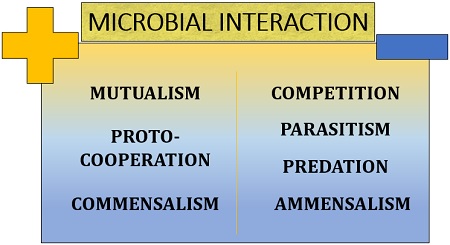
Content: Microbial Interaction
Definition of Microbial Interaction
Microbial interaction is defined as the biological interaction where one group of microorganisms interact with the other to establish and maintain the relationship, which can be positive or negative. The microbial interaction between the same organisms is called intraspecific interaction. Similarly, the microbial interaction between the different organisms is known as interspecific interaction.
Types of Microbial Interaction
There are two types of interaction based on positive and negative affect.
Positive Microbial Interaction
It is the type of interaction, where both the individuals interact or cooperate to establish a positive relationship for each other’s mutual benefit. In positive interaction, the organisms of two different population can build a consistent, transitory and obligatory relationship. There are three types of positive interaction as we can see in the image:
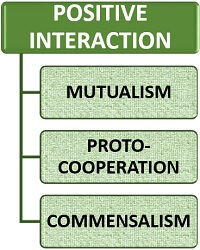
Mutualism
It is a positive interaction where both the microbial population are interdependent for mutual benefit. The effect of mutualism is positive for both the population. Both the interacting individuals in mutualism are termed symbionts. Thus, mutualism is a type of symbiotic relationship, in which the two organisms closely live together. Therefore, the effect of mutualism is +/+, as a result of an interaction.
Examples:
- The interaction between gut flora and humans: Some microbes reside within the digestive tracts of humans and are considered gut microflora or gut microbiota. The intestinal microflora includes some bacteria, archaea and fungi those live symbiotically in the human’s gut. The gut microflora benefits by harnessing the energy stored in the human body and also provide benefit to the host (human) by providing resistance against the colonization of exogenous microbes, promotes vitamin synthesis, helps in digestion and develops a competent immune system.
- An interaction between Trichonympha and Termites: Trichonympha is a protozoan that helps in degrading the complex carbohydrate (cellulose) present in the wood into simple sugars, which is utilized by the termites. The Trichonympha lives symbiotically in the termite’s gut and benefits by getting shelter and constant food supply through the termites’ chewing action.
- Chlorella’s interaction with Paramecium: Paramecium bursaria (ciliated protist) harbours the algal cells of Chlorella species. The Chlorella sp. resides within the cytoplasm of P. bursaria and both functions as a host for each other. P. bursaria supplies carbon dioxide and protects the thousands of algal cells. At the same time, Chlorella sp. (endosymbiont) helps P. bursaria to survive in anaerobic conditions and provides maltose as a source of energy.
Protocooperation
It is very similar to mutualism. Unlike mutualism, the two interacting species in protocooperation are not dependent on each other, i.e. they only interact for the benefit they will get. The organisms involved in protocooperation do not share an obligatory relationship, i.e. the organisms are not closely dependent on each other. Therefore, the effect of proto-cooperation is +/+, as a result of an interaction.
Examples:
- The interaction between Desulfovibrio and Chromatium: Both Desulfovibrio and Chromatium cooperate and participate in the carbon and sulphur cycle.
- The interaction between nitrogen-fixing bacteria and Cellulomonas: Both nitrogen-fixing bacteria and Cellulomonas cooperate in the nitrogen cycle.
Commensalism
It is the third type of positive interaction. In commensalism, the one organism associated with the other is benefitted called commensal, while the other organism is neither benefitted nor harmed. Therefore, the effect of commensalism is +/0, as a result of an interaction.
Examples:
- The interaction between Flavobacterium and Legionella pneumophila: Flavobacterium secretes cystine that helps in the survival of Legionella pneumophila in the aquatic habitat. Legionella pneumophila thrives in an aquatic habitat.
- Nitrosomonas and Nitrobacter’s interaction: The Nitrosomonas oxidize ammonia to nitrite and Nitrobacter uses nitrite to get energy and oxidizes it into nitrate.
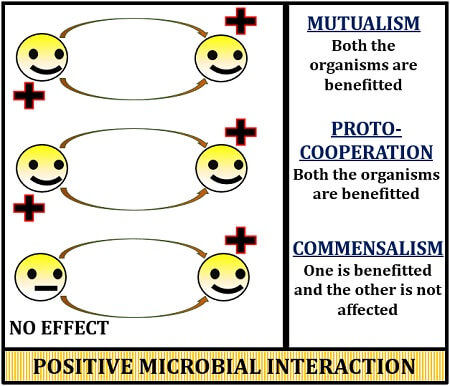
Negative Microbial Interaction
It is the type of interaction between the two microbial populations, in which the one population of the microorganisms is benefitted, while the other is affected. One organism either attacks or inhibits the other organisms for the survival and food source in a negative interaction.
There are four types of negative interaction, as we can see in the picture:
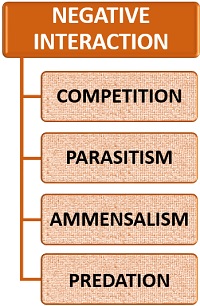
Competition
It is a type of negative interaction, where two different organisms compete with each other for the same resources. Due to competition for the same resources, there is a limitation of resources by which both the organisms are adversely affected. The competition between the same species’ organisms is called intraspecific competition and the competition between the organisms of different species is known as Interspecific competition. Therefore the effect of the competition is -/-, as a result of an interaction.
Examples:
- The interaction between Paramecium cadatum and Paramecium aurelia: Paramecium cadatum and Paramecium aurelia compete for the same bacteria as a food source. P. aurelia outcompetes P. cadatum to survive.
Parasitism
It is a negative interaction, where one organism closely depends and lives upon the other to invade all the nutrients is called a parasite. The parasite that attacks the other organism is called a host. In parasitism, the host-parasite relationship is an obligatory interaction where a parasite strongly needs a long interaction for its growth and multiplication.
The parasites living outside the host cell are called ectoparasites. The parasites living inside the host cell are called endoparasite. In parasitism, one organism (parasite) will be benefitted, and the host cell will be destroyed. Therefore, the effect of parasitism is +/-, as a result of an interaction.
Examples:
- The interaction between virus and bacteria: The bacteriophages are the viruses that hunt bacteria. They infect bacteria by penetrating their viral genome into the host cell’s cytoplasm where the genome replicates and translates structural proteins for the assembly of the parasites (bacteriophages). Thus, the bacteriophages hijack the bacterial cell machinery to increase their own population.
- Bdellavibrio and gram-negative bacteria interaction: Bdellavibrio bacteriovorus acts as a parasite for some of the gram-negative bacteria. Bdellavibrio bacteriovorus penetrates the gram-negative bacterial cell and resides in the periplasmic space for a short period of time. Later, Bdellavibrio bacteriovorus degrades the peptidoglycan layer and ruptures the host cell via hydrolytic enzymes to release its progenies.
Ammensalism
It is also called Antagonism. It is a type of negative interaction where one organism produces inhibitory substance for the other. One population is either unaffected or benefitted, and the other is inhibited in the ammensalism. It is a type of chemical inhibition. Therefore, the effect of predation is 0/-, as a result of an interaction.
Examples:
- The vaginal tract produces lactic acid, which inhibits the pathogenic species like Candida albicans.
- Skin microflora produces fatty acids that restrict the growth of pathogenic bacteria of the skin.
- Penicillium is a fungus that secretes penicillin, which acts as an inhibitory substance for bacteria’s growth.
- Thiobacillus thiooxidant produces sulphuric acid, which inhibits most of the bacteria’s growth by lowering culture media’s pH.
Predation
It is a type of negative interaction, where one organism engulfs or attacks the other organism is called a predator. The predator that attacks the other organism is called prey. One organism (predator) is benefitted in predation, and the other (prey) is killed. Therefore, the effect of predation is +/-, as a result of an interaction.
Example:
Bdellavibrio and some protozoans are the predators that attack the other bacteria.
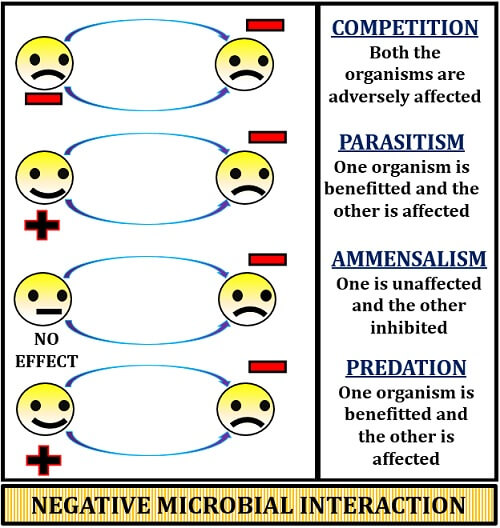
Conclusion
Therefore, we can conclude that all the biotic components like plants, animals, and microorganisms somehow relate to each other for the food, resources, and survival in the ecosystem. The interaction can occur either between the organisms of the same species or different species. Hence, some organisms cooperate for mutual benefit, and some compete with each other. The interaction between the two microbial population will definitely produce an effect which can be in one way or reciprocal.